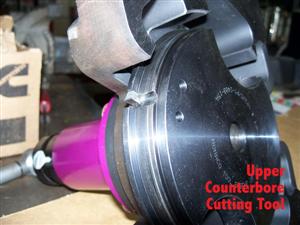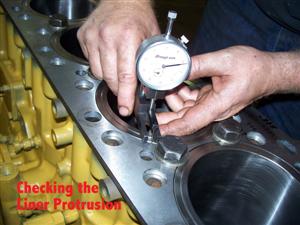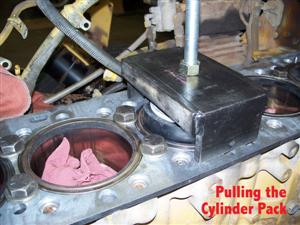July 2008 - Performance Zone
BLOWN CAT HEAD GASKETS
By Performance Specialist Bruce C. Mallinson
Over the years we have noticed that many shops do not check the liner protrusion on Caterpillar engines when installing a new head gasket or rebuilding the engine. This fact is very alarming to me because proper liner protrusion is critical to the life of the head gasket. Liner protrusion, for those of you that do not know, refers to how far the cylinder liner protrudes above the spacer plate on the top of the block. If the liner does not protrude enough, the head gasket can, and will, fail. Proper protrusion (or even a little “extra” protrusion) forms a better seal and helps the head gasket to withstand the forces put on it under normal and severe working conditions.
Whenever an owner-operator comes into our shop that has had a Cat head gasket replaced or their engine rebuilt, I always ask them what the liner protrusion was – and, to my surprise, they can never tell me. When I have them go back and ask the mechanic who did the work the answer is always, “It’s within spec.” I’m sorry, but that’s not a good answer – it’s a cop out. Most likely the mechanic either never checked it or took the time to write it down.
 If you don’t have at least .005 to .007 liner protrusion, the head gasket will blow. Right now, in our shop, sits a C-16 Cat with 600 horsepower and 499,000 original miles on the engine. Just 16 months ago an authorized Caterpillar shop replaced the head and head gasket, and now it is sitting in our shop after blowing again. We removed the head, cleaned the block surface, cleaned the spacer plate, installed a new shim gasket (the gasket between the block and the spacer plate), and installed the hold down bolts which hold the spacer plate tightly to the block, and then measured the liner protrusion. What we found did not surprise us.
If you don’t have at least .005 to .007 liner protrusion, the head gasket will blow. Right now, in our shop, sits a C-16 Cat with 600 horsepower and 499,000 original miles on the engine. Just 16 months ago an authorized Caterpillar shop replaced the head and head gasket, and now it is sitting in our shop after blowing again. We removed the head, cleaned the block surface, cleaned the spacer plate, installed a new shim gasket (the gasket between the block and the spacer plate), and installed the hold down bolts which hold the spacer plate tightly to the block, and then measured the liner protrusion. What we found did not surprise us.
This C-16 Cat engine in our shop, after suffering its second head gasket failure, had a .002 liner protrusion, which is not enough, and the reason that the head gasket only lasted 16 months. The mechanic should have removed the cylinder packs, cut the counterbores to .026, added a .030 stainless Cat shim, and then reinstalled the cylinder packs. If that was done, the protrusion would have been .006 and the head gasket would not have failed.
 Let’s face it – if an engine runs for 500,000 miles before losing a head gasket that is not so bad. However, fix it right the first time. My message to all of the Cat mechanics out there would be to do what it takes to get the liner protrusion where it should be so that the owner-operator in your shop won’t have any more problems.
Let’s face it – if an engine runs for 500,000 miles before losing a head gasket that is not so bad. However, fix it right the first time. My message to all of the Cat mechanics out there would be to do what it takes to get the liner protrusion where it should be so that the owner-operator in your shop won’t have any more problems.
This is the first article in a series that will focus on some of the issues and topics of concern when rebuilding a Caterpillar engine. The photos show examples of some of the things discussed in this article. I hope this series of articles and photos that go with them are helpful to both mechanics and truck owners alike. If you have any questions or comments, please feel free to call me at the shop at (724) 360-4080 or e-mail me at bruce@pittsburghpower.com.
